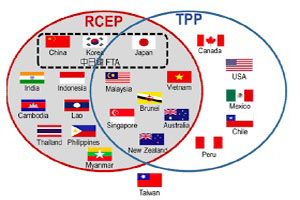
US withdrawal from TPP, to push for successful conclusion of RCEP
YarnsandFibers News Bureau 2017-01-31 16:00:00 – Kuala LumpurThe United States withdrawal from the Trans-Pacific Partnership (TPP) to spur momentum for the successful conclusion of the Regional Comprehensive Economic Partnership (RCEP), a proposed free trade agreement between the ten member states of the Association of Southeast Asian Nations (ASEAN) (Brunei, Cambodia, Indonesia, Laos, Malaysia, Myanmar, the Philippines, Singapore, Thailand, Vietnam) and the six states with which ASEAN has existing free trade agreements (Australia, China, India, Japan, South Korea and New Zealand).
Asia Pacific Chief Economist, Rajiv Biswas, said that US President Donald Trump’s signing of an executive order, confirming the country’s exit from the TPP, would accelerate a significant shift in the trade policy landscape in the Asia Pacific region.
The US withdrawal would also help strengthen China’s economic leadership position in the Asia Pacific, in respect of the RCEP and Free Trade Area of the Asia-Pacific (FTAAP).
China is also undertaking its own regional economic initiatives, such as the One Belt One Road regional strategy as well as playing a major role in creating new development finance institutions such as the Asian Infrastructure Investment Bank (AIIB).
China is likely to play a much stronger lead role in the future Asia Pacific trade architecture through a number of multilateral trade liberalisation initiatives, notably the RCEP and FTAAP..
At the Asia-Pacific Economic Cooperation (Apec) Summit held last November in Lima, Peru, two Latin American TPP member countries, Chile and Peru, also expressed interest in joining the RCEP negotiations. This was on expectations that the TPP would stall.
The RCEP is an Asia-Pacific trade liberalisation initiative led by China that includes the ten Asean members as well as Australia, New Zealand, Japan, South Korea and India.
The FTAAP encompasses all 21 Apec economies through trade liberalisation and once established, would become the world’s largest free trade zone, covering 57 percent of the global economy and nearly half of world trade.
Biswas said that Apec leaders had also reaffirmed their commitment to move forward with a longer term vision of creating the FTAAP, with next steps set out in the Lima Declaration.
As the FTAAP would be realized outside of Apec, but in parallel with the organisations’s process, this creates greater flexibility in case some members do not wish to pursue the vision.
Meanwhile, on the impact of US withdrawal from the TPP on Malaysia, the country’s export growth outlook had been significantly impacted by the US decision.
The Vietnamese and Malaysian manufacturing export sectors were expected to be among the largest beneficiaries of the TPP due to the much improved market access to North America. It would have provided a large boost to Vietnam’s textile exports.
Biswas said that US withdrawal from TPP is also a blow to Japanese Prime Minister Shinzo Abe and his economic reform plans for the country as the trade pact was a key pillar of the Third Arrow structural reforms under Abenomics.
While the other 11 TPP members could create a parallel agreement without the US and move forward, the economic benefits would be significantly reduced.
However, President Donald Trump has expressed his intention to pursue bilateral trade negotiations with other TPP member countries, this approach may provide opportunities for further trade liberalization between them.
The gross domestic product (GDP) of the US accounted for around 68 percent of the combined GDP of the 12 TPP negotiating partner countries. There is a silver lining in the US aborting the trade deal.
Market Intelligence
Ask for free sample Report

experience
Customer Base
dedicated team
Countries Served Worldwide









